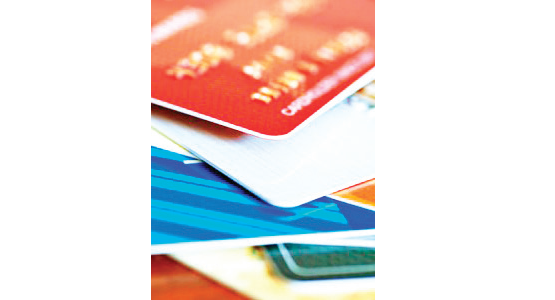The number of Automated Teller Machine (ATM) cards so far issued by commercial banks in Nigeria has hit 41.89 million, ABB has gathered.
These include the Chip and PIN ATM card brands from indigenous Verge, MasterCard and Visa. This was contained in the country’s latest electronic payment fact sheet released by the Nigerian Interbank Settlement System (NIBSS).
According to the NIBSS report, total number of ATMs in Nigeria’s as at March 2016 stood at 16,660, total number of active cards 41.89 million; while the volume and value of ATM transactions between January and March, 2016, stood at N0.12 billion and N1.07 trillion respectively.” Also, on mobile money operations in first quarter, the report said that total number of customers as at March 2016 stood at 29.13 million; total number of agents enrolled was 106,636, transaction volume within the quarter seated at 14.09 million, while transactions value averaged N0.14 trillion.
Till date, the Central Bank of Nigeria (CBN) has licensed 21 mobile money operators (MMOs), with all of them already integrated to NIBSS platform for Interoperability, the report said. Meanwhile, the NIBSS report has also indicated that Nigerian banks have issued over 24 million Bank Verification Numbers (BVNs) to their customers as at end of March, this year.
According to the study, while over 30.1 million account holders had enrolled for the BVN, only 24 million had received their verification numbers.
The number of enrolled bank customers, thus, represents about 34.7 per cent of the total 86.5 million banks accounts opened by government, corporate and individuals with various banks in the country.
Executive Director, Technology and Operations, NIBSS, Mr. Niyi Ajao, said the purpose of the project is to use biometric information as a means of first identifying and verifying all individuals that have account(s) in any Nigerian bank and consequently, as a means of authenticating customer’s identity at point of transactions. He said the BVN exercise would also provide a uniform industrially accepted unique identity for bank customers, to authenticate transactions without the use of cards using only biometric features and Personal Identity Number (PIN) identification of blacklisted customers.
According the NIBSS, starting from January 2015, 2.2 million accounts were enrolled; 2.7 million in February; 3.3 million March and by April, May and June, the figures have increased to 7.7 million; 9.2 million and 12.4 million respectively. In July, August and September, the figure rose to 12.7 million; 13.7 million and 14. 5 million accounts while in the last quarter of the year, 16.3 million accounts were enrolled in October; 21.2 million in November and in December, the figure stood at 28.2 million. However, in the first quarter of this year, the number of enrolled bank accounts for BVN further increased to well over 32.1 million.
The data has also revealed that the number of bank accounts opened with different banks in the country so far had reached 86.5 million. The number of accounts opened so far in the country has increased from 75 million in January last year to reach 85 million by the end of December last year. Last January, the number of bank accounts residing with various banks seated at 86.5 million. Further analysis of the bank accounts data, however, showed that the total active accounts in the country dropped from 59 million last December to 58.5 million at the end of January this year. This means that only 67 per cent of the total bank accounts opened in the country are active while 33 per cent are redundant.
Also, as at last January, 59.7 million bank accounts were Savings Accounts; 23.4 million were Current Accounts; while other forms of accounts such as domiciliary, fixed deposit, among others, were 3.3 million.
Meanwhile, despite the number of inactive accounts, most account holders significantly used various electronic payment platforms for transaction in 2015. NIBSS data for transactions activities for 2015 had shown that over N35.5 trillion transactions were carried out on various electronic payment platforms, according to NIBSS Electronic Fact Sheet for the Year 2015.
The transactions were executed through the Nationwide Cheque Truncations Services (NCTS) platform, (NEFT), NIBSS Instant Pay (NIP), the Electronic Bills Payment (E-billspay), Point of Sales (POS), Automated Teller Machines (ATMs) and Mobile Money Operators (MMOs).
The study has also revealed that Nigerians are currently moving away from traditional cheque transaction to a more convenient electronic means of carrying out financial exchanges, as the value of halfyear cheque transactions this year dropped by more than 10 per cent.
The decline compares with the value of transaction during the same period last year, where more cheque transactions took place, according to NIBSS. According to the report, from a total of N3.194 trillion cheque issuance value in the first half of last year, the figure crashed to N2.894 trillion during the same period this year.
The N300 billion transaction difference, thus, represents about 10.36 per cent decline in cheque transactions this year. Details of the data showed that in January, February and March last year, cheque issuance values stood at N541.062 billion; N548.116 billion and N565.138 billion respectively.
In April, the transaction value was N510.442 billion; N487.937 billion in May and in June 2015, the figure stood at N542.08 billion. There were general declines in monthly cheque transactions value this year, as N464.553 billion was executed in January, N501.166 billion in February and N487.572 billion in March, ending first quarter, according to the report.
In the second quarter of the year, spanning April, May and June, cheque transactions were valued at N472.465 billion; N480.409 billion and N488.627 billion respectively. In terms of volume of transactions, the NIBSS’ report indicates that while the total number of deals stood at 6, 407, 507 in 2015, only 5, 731, 805 units of transactions were recorded this year.
This means that there was a decline in the volume of transactions by 675,702 this year when compared with last year.



